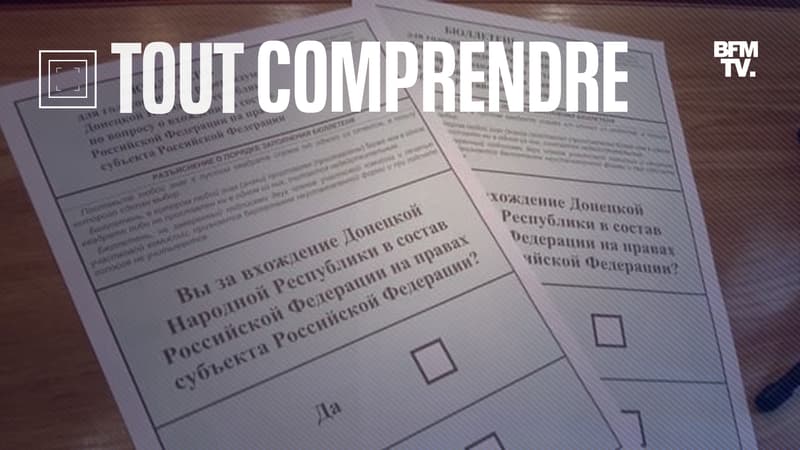From this Friday, and for the next five days, until September 27, annexation “referendums” have been organized in regions of Ukraine controlled, totally or partially, by Russia.
These votes, following the model of the one that formalized the annexation of the Crimean peninsula, in the south of Ukraine, by Russia in 2014, have been preparing for several months and mark an escalation of the conflict. Moscow even threatens nuclear attacks to defend “its” territory.
• Which regions are involved?
As Russia prepares to enter its eighth month of war against Ukraine, Moscow-installed authorities in four regions of the country announced Tuesday the holding of emergency “referendums” on annexation.
These elections will take place in the Donetsk and Lugansk regions, whose independence Russian President Vladimir Putin recognized shortly before launching his offensive against Ukraine on February 24. It was the head of the self-proclaimed Luhansk “parliament”, Denis Miroshnichenko, who first announced that the vote would take place this week, before being followed by the Donetsk separatist leader.
Two other occupied regions are affected by these elections: Kherson province and Zaporizhia province. Unlike the Donetsk and Lugansk oblasts, these areas were never recognized as independent by Russia.
• How will the vote take place?
Voting began this Friday at 7 am French time. With fighting still ongoing and a Ukrainian counteroffensive gaining ground, the Donetsk separatists’ electoral body said “for security reasons” the vote would be organized mainly door-to-door for four days.
The polling stations will only open on the “last day”, that is, on September 27. A total of 450 and 461 polling stations will be opened respectively in the Donetsk and Luhansk regions. Zaporijjia will have 394, and the Kherson region 198. More than two million ballots have already been printed.
Several polling stations have also been opened in Russia to allow “refugees” who fled the fighting to vote, according to Russian news agencies.
Thus, the inhabitants of the pro-Russian separatist regions of Donetsk and Luhansk, who have already declared their “independence”, will have to decide whether or not they want to be part of Russia. In the Kherson and Zaporizhia regions, partially occupied by Russian forces, the question is asked: “Do you want to break away from Ukraine, create independent states and become part of Russia?”
• Why are these votes contested?
These “referendums” are reminiscent of Moscow’s annexation of Crimea in 2014 and have been heavily criticized by Kyiv and the international community.
Because its result is not in doubt, due to the biased profile of the voters. Interviewed by BFMTV, Lukas Aubin, director of research at IRIS, believes that “most of the people who are going to vote are members, whether they are pro-Russian politicians or soldiers in the Russian army who are obviously going to vote for the annexation of Russia.” these four regions to Russia”.
“Our position does not change based on this noise or any other announcement,” Ukrainian President Volodymyr Zelensky said on Tuesday, calling for “maintaining pressure” on Russia.
“Let’s preserve our unity, protect Ukraine, liberate our land and show no weakness,” he urged.
The United States has denounced “farces,” saying Joe Biden’s country “would never recognize Russia’s claims to allegedly annexed parts of Ukraine.” Similarly, France lambasted a “parody”, an “additional provocation” by Russia, which “will have no consequences in the position that is ours”.
“The very idea of organizing referendums in regions that have known war, that have suffered bombing is the signature of cynicism,” denounced Emmanuel Macron, on the sidelines of his speech before the UN general assembly on Tuesday.
A unanimous international condemnation: even China, close to Moscow, seemed to distance itself after the announcement of referendums, calling for respect for the territorial integrity of States.
• What does this mean for the rest of the conflict?
Tuesday’s hasty announcement of these “referendums” comes as Moscow, struggling to regain control of Ukraine after a series of setbacks, has made the decision to throw more forces into the battle. President Vladimir Putin thus decreed on Wednesday a partial mobilization of Russians of fighting age, which will affect at least 300,000 people.
These “referendums” are therefore an opportunity for the Russian leader to “send conscripts, conscripts, the 300,000 who are on Russian soil” to these annexed territories, Colonel Michel Goya, a defense consultant, analyzes for BFMTV.
Furthermore, while the outcome of these “referendums” is indubitable, in areas fully or partially controlled by Moscow, they herald an escalation in the conflict. If Moscow officially annexes these four Ukrainian regions, any direct or indirect attack against them would be tantamount to attacking Russia.
An escalation that is all the more important given that Vladimir Putin continues to brandish the nuclear threat. Accusing Westerners of wanting to “destroy” Russia, he threatened to use “all means,” including nuclear means, to defend what he sees as Russian territory.
Source: BFM TV


